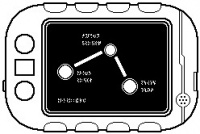DataCaster
| DataCaster | |
|---|---|
 TBD | |
| Type | Electronic Warfare Device |
| Tech Level | TL–10 |
| Cost | Various |
| Size | Various |
| Weight | Various |
| Manufacturer | Various |
| Also see | Ship Equipment |
| Reference | T5 Core Rules 388. |
| TBD | |
A DataCaster is an electronic warfare weapon. [1]
- CommCasters and DataCasters use Data Broadcasts or Beamcasts to send data at the target. [2]
- It is a kind of Ship Equipment that functions as a Transmitter and a Jammer. [3]
Description (Specifications)
DataCasters are starship-mounted offensive weapons designed to overwhelm enemy sensors with excessive amounts of malicious data, preventing them from properly functioning. In addition, DataCasters can jam communications and potentially install computer virii in insufficiently protected enemy computers. DataCasters are typically turret-mounted. [4]
- Their efficacy is based largely on their tech level compared to the target's tech level. [5]
Image Repository
Functional Explication
DataCasters are offensive weapons broadcasting or beamcasting petabytes (...or even larger packages of zottabytes or more) of information at or against enemy sensors and communicators. DataCasters most often pursue three strategies:
- They attempt to spoof or overload sensors.
- They attempt to introduce viruses into onboard computer systems through flaws in sensor inputs.
- They transmit tailored psychological messages and propaganda. [6]
Specific Capabilities
Specific attacks and mechanisms include:
- Sensor Overload: Successful datacaster attacks on an enemy ship's sensor or communications equipment may inflict damage on specific ship component/s. [7] This occurs through overloading and deliberate misfunction instruction of the electronics device. [8]
- Intelligent Ordnance Spoofing: One purpose of datacasters is to communicate with enemy Self-Aware Missile Brains. Successful attacks shock the offending missile's brain into inaction or may even cause the ordnance to turn on its originating launchers. [9]
- Virus Implantation: Successful datacaster attacks on non-Sensor or non-comm locations may insert a virus. A virus successfully introduced onto a ship may disables the equipment components of a ship. Viruses can spread to adjacent ship equipment. A virus may be isolated and destroyed if all computer connections are cut between infected locations and other uninfected locations. [10]
- Computers may operate independently; but independent operation may prevent shipboard use of batteries, commcasters, and restrict naval weapons to reduced ranges or limited functionality. [11] This requires some familiarity with the computer architecture of the target, but Charted Space has seen many eras where most major polities' architectures were mostly stable over a period of at least centuries, allowing their opponents to pick up this familiarity. [12]
- The series of entities known as Virus are this type of virus, and are named for spreading themselves in this manner, but they are not the only type. Non-Virus viruses have sometimes been employed to attack Virus, though rarely to much success. [13]
- Psychological Attacks: Datacaster attacks provide a shifting series of morale attacks, false messages, appeals to a variety of cultural and social fears. Psychological attacks challenge the sanity of crew, passengers, staff, and troops. [14] A successful datacaster may cause psychological distress to crewsophonts or possibly even drive them insane under extreme conditions. [15]
History & Background (Dossier)
The Terrans used DataCasters to great effect against the Vilani in the early period of the Interstellar Wars. For over a century, wars on Terra had involved an electronic warfare component, and Terran nations had developed myriad systems for overwhelming and disabling adversarial computer systems. The Vilani had no such traditions. They had not encountered malicious computer code before, and their previous enemies did not utilize electronic warfare. [16]
Terran DataCaster Experience
One of the most infamous Terran DataCaster attacks during their TL:7-9 tech epoch involved the implantation of a computer worm or virus known as Stuxxnet, or Stuck-Net, which disabled or destroyed an entire network of strategic weapon laboratories and weapons for an ancient Terran balkanized polity. [17]
References & Contributors (Sources)
| This page uses content from Wikipedia. The original article was at Electronic_warfare. The list of authors can be seen in the page history. The text of Wikipedia is available under the Commons Attribution-ShareAlike 3.0 Unported License. |
| This page uses content from Wikipedia. The original article was at Stuxnet. The list of authors can be seen in the page history. The text of Wikipedia is available under the Commons Attribution-ShareAlike 3.0 Unported License. |
- Jordan Weisman. "Book 2." Adventure Class Ships Volume 1 (1982): TBD.
- Marc Miller. T5 Core Rules (Far Future Enterprises, 2013), 342-343, 381, 386, 390, 409, 413, 415, 508, 525, 617.
- Traveller Wiki Editorial Team
- Author & Contributor: Lord Matthew Kerwin Baron Thon
- Author & Contributor: Lord (Marquis) and Master of Sophontology Maksim-Smelchak of the Ministry of Science
- ↑ Information provided to the library by Matthew Kerwin
- ↑ Marc Miller. T5 Core Rules (Far Future Enterprises, 2013), 386.
- ↑ Information provided to the library by Maksim-Smelchak
- ↑ Information provided to the library by Matthew Kerwin
- ↑ Information provided to the library by Matthew Kerwin
- ↑ Marc Miller. T5 Core Rules (Far Future Enterprises, 2013), 388.
- ↑ Marc Miller. T5 Core Rules (Far Future Enterprises, 2013), 388.
- ↑ Information provided to the library by Maksim-Smelchak
- ↑ Marc Miller. T5 Core Rules (Far Future Enterprises, 2013), 525.
- ↑ Marc Miller. T5 Core Rules (Far Future Enterprises, 2013), 388.
- ↑ Information provided to the library by Maksim-Smelchak
- ↑ Information provided to the library by Adrian Tymes
- ↑ Information provided to the library by Adrian Tymes
- ↑ Marc Miller. T5 Core Rules (Far Future Enterprises, 2013), 388.
- ↑ Information provided to the library by Maksim-Smelchak
- ↑ Information provided to the library by Matthew Kerwin
- ↑ Information provided to the library by Maksim-Smelchak